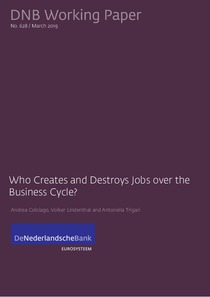Who creates and destroys jobs over the business cycle?
"Using US annual data spanning four decades and several business cycles, we show that that job flow rates of young firms are more cyclical than those of mature firms and detect no difference between the cyclicality of job flow rates of small and large firms. Further, we find that job flow rates...
| Main Authors: | , , |
|---|---|
| Institution: | ETUI-European Trade Union Institute |
| Format: | TEXT |
| Language: | French |
| Published: |
Amsterdam
2019
DNB |
| Subjects: | |
| Online Access: | https://www.labourline.org/KENTIKA-19307373124911255559-Who-creates-and-destroys-jobs-.htm |
| Summary: | "Using US annual data spanning four decades and several business cycles, we show that that job flow rates of young firms are more cyclical than those of mature firms and detect no difference between the cyclicality of job flow rates of small and large firms. Further, we find that job flow rates due to contractions and expansions of continuing establishments are more cyclical than those due to entry and exit. At the same time the job flow rates of mature firms provide a larger contribution to the overall variability of aggregate job flow rates with respect to those of young firms. The reason is that mature firms employ the vast majority of US workers, and the fraction of aggregate variability of aggregate job flows explained by the job flow of firms belonging to a specific category is proportional to the category's employment share. On the contrary, there is no relevant difference in the contribution to aggregate fluctuations between the job flow rates of firms of different sizes. Our findings hold independently of whether we focus simply on the Great Recession period or on the full sample." |
|---|---|
| Physical Description: | 51 p. Digital |

